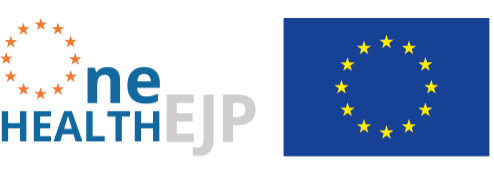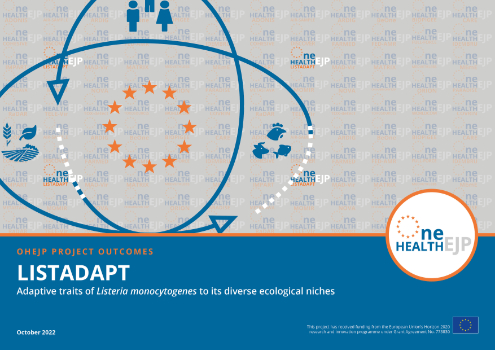14 Rue Pierre et Marie Curie, Maisons-Alfort, Île-de-France, France
147 Rue de l'Université, Paris 7e Arrondissement, Île-de-France, France
Ullevålsveien 68, Oslo, Oslo, Norway
Teramo, Abruzzo, Italy
Vienna, Wien, Austria
Uppsala, Sweden
Anker Engelunds Vej 1, Stampen, Region Hovedstaden, Denmark

The Project #LISTADAPT
| Start: | 1 January 2018 |
| Duration: | 2 Years |
| Domain: | Foodborne Zoonoses |
| Keywords: | WGS, Listeria monocytogenes, adaptation, genetic and phenotypic traits, detection |
| Contact: | Sophie Roussel (ANSES) |
ListAdapt: Adaptive traits of Listeria monocytogenes to its diverse ecological niches
The ListAdapt project aims were to decipher the molecular mechanisms of the adaptation of Lm to its various ecological niches by comparing both genotypic and phenotypic data from a large and balanced set of strains from environment, animals, foods and clinical cases in several European countries.
The food-borne bacteria, Listeria monocytogenes (Lm), causing the disease of listeriosis, is together with Salmonella and STEC, the main causative agent for foodborne infections in EU, in terms of severity of the illness and fatality rate (EFSA-ECDC, 2015). It is a life-threatening disease because of the high mortality (20-30 %) and hospitalization (98.9 %) rates. A significant increase in the occurrence of listeriosis has been recorded since 2008 in Europe and this highlights listeriosis as a serious re-emerging health problem. In 2014, 2,161 confirmed human cases of listeriosis have been reported in Europe ECDC atlas, EFSA-ECDC, 2015). However, the ecology of Lm is still poorly understood and the capacity of some strains to adapt to the environmental conditions found in the food industry makes production of high quality, safe food a major challenge.
To elucidate which genes and molecular mechanisms underlie the adaptation of Lm to its different ecological niches, ListAdapt used standard operating procedures (SOPs) for the production and analysis of Whole Genome Sequencing (WGS) data and bioinformatics tools previously developed for EU Horizon 2020-COMPARE project.
The ListAdapt consortium included the European Union Reference laboratory (EURL) for Lm, 7 National Reference Laboratories (NRL) for Lm of which two also are National Public Health Laboratories and the EURL for antimicrobial resistance. The NRLs expert in WGS trained the others to COMPARE –SOPs and bioinformatics toolbox and stimulated them to use WGS for the surveillance of Lm in their country. This multidisciplinary project was found to benefit from the (i) expertise of partners in food safety as well as animal and public health, (ii) high- level infrastructures and (iii) 9000 strains already available within the consortium of which 2000 are whole sequenced.
The project has improved scientific knowledge on the ecology of the bacteria by gaining insight into the adaptation, evolution and genetic make-up of strains that are successful in some environmental niches and not in others. Furthermore, the project trained Reference Laboratories to use WGS using COMPARE-Standard Operating Procedures (SOPs) and encouraged them to use WGS for the surveillance of Lm in their country. Finally, the new diagnostic tests aimed at identifying strains in food and animal reservoirs have arisen from this project. These new tests should become key tools to improve the surveillance system, to assist the food industry in improving food safety and may have a significant economic impact and important benefit for society.
Project Outputs and Outcomes
Please read the project impact brochure, for more information on ListAdapt’s outputs and outcomes.
It is also available on Zenodo.
Project Assets
Félix, B., Sevellec, Y., Palma, F. et al. (2022). A European-wide dataset to uncover adaptive traits of Listeria monocytogenes to diverse ecological niches. Science Data. 9, 190. DOI: https://doi.org/10.1038/s41597-022-01278-6
Douarre, P. E., Sévellec, Y., Le Grandois, P., Soumet, C., Bridier, A., Roussel, S. (2022). FepR as a central genetic target in quaternary
ammonium compounds (QAC)-adaptive process and cross-resistance to ciprofloxacin in Listeria monocytogenes. Frontiers in Microbiology. 13, 864576. DOI: https://doi.org/10.3389/fmicb.2022.864576
Sévellec, Y., Ascencio, E., Douarre, P. E., Félix, B., Gal, L., Garmyn, D., Guillier, L., Piveteau, P., Roussel, S. (2022). Listeria monocytogenes:
Investigation of fitness in soil does not support the relevance of ecotypes. Frontiers in Microbiology. 13, 917588. DOI: https://doi.org/10.3389/fmicb.2022.917588
Palma, F., Radomski, N., Guérin, A., Sévellec, Y., Félix, B., Bridier, A., Soumet, C., Roussel, S., Guillier, L. (2022). Genomics elements located in the accessory repertoire drive the adaptation to biocides in Listeria monocytogenes strains
from different ecological niches. Food Microbiology. 106, 103757. DOI: https://doi.org/10.1016/j.fm.2021.103757
Pietzka, A., Murer, A,. Lennkh, A., Hauser, K., Vötsch, K., Springer, B., Allerberger, F., Ruppitsch, W. (2021). Draft genome sequences of two Listeria monocytogenes strains isolated from invasive snails (Arion vulgaris) in Austria in 2019. Microbiology Resource Announcements. 10:e00375-21. DOI: https://doi.org/10.1128/MRA.00375-21
Guérin, A., Bridier, A., Le Grandois, P., Sévellec, Y., Palma, F., Félix, B., Roussel, S., Soumet, C. (2021). Exposure to Quaternary Ammonium Compounds Selects Resistance to Ciprofloxacin in Listeria monocytogenes. Pathogens. 10, 220. DOI: https://doi.org/10.3390/pathogens10020220
Gelbicova, T., Florianova, M., Hluchanova, L., Kalova, A., Korena, K., Strakova, N., Karpiskova, R. (2021). Comparative Analysis of Genetic Determinants Encoding Cadmium, Arsenic, and Benzalkonium Chloride Resistance in Listeria monocytogenes of Human, Food, and Environmental Origin. Frontiers in Microbiology. 11, 599882. DOI: https://doi.org/10.3389/fmicb.2020.599882
Torresi, M., Orsini, M., Acciari, V., Centorotola, G., Di Lollo, V., Di Domenico, M, Manila Bianchi, D., Wakwamba Ziba, M., Tramuta, C., Cammà, C., Pomilioa, F. (2020). Genetic Characterisation of a Listeria monocytogenes Serotype IV b Variant 1 Strain Isolated from Vegetal Matrix in Italy. Microbiology Resource Announcements. 9:e00782-20. DOI: https://doi.org/10.1128/MRA.00782-20
Sévellec, Y., Torresi, M., Félix, B., Palma, F., Centorotola, G., Bilei, S., Senese, M., Terracciano, G., Leblanc, JC., Pomilio, F., Roussel, S. (2020). First report on the occurrence of Listeria monocytogenes ST121 strain in a dolphin brain. Pathogens. 9 (10), 802. DOI: https://doi.org/10.3390/pathogens9100802
Félix B, Feurer C, Maillet A, Guillier L, Boscher E, Kerouanton A, Denis M, Roussel S. Population Genetic Structure of Listeria monocytogenes Strains Isolated From the Pig and Pork Production Chain in France. Front. Microbiol., 06 April 2018. DOI: 10.3389/fmicb.2018.00684




